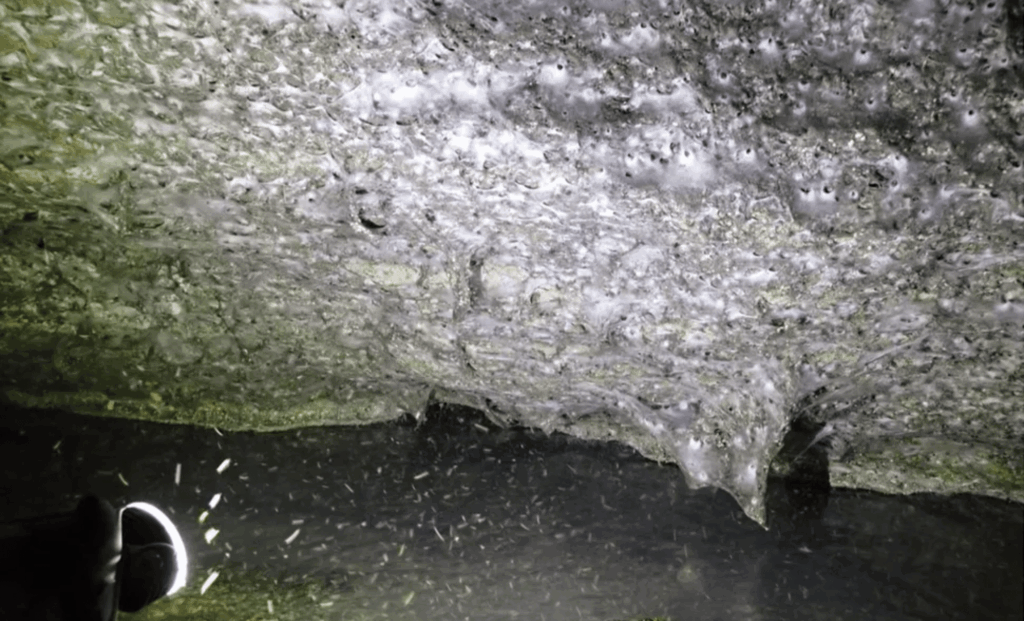
Deep in the darkness of a sulfur-filled cavern on the Albanian-Greek border, scientists have stumbled upon what may be the largest spiderweb ever discovered. The tangled mass stretches across the Sulfur Cave, a hidden world teeming with life despite its toxic atmosphere. Inside, over 111,000 spiders thrive together in complete darkness—an astonishing display of cooperation from species once thought to be solitary.
A Hidden Megacity of Spiders Beneath the Earth
When biologist István Urák from the Sapientia Hungarian University of Transylvania first entered the Sulfur Cave, he encountered something few humans ever have: a spider-built metropolis stretching across the cavern’s sulfurous walls. His research, published in the journal Subterranean Biology, revealed a dense colony formed by two common yet unexpectedly social species — Tegenaria domestica and Prinerigone vagans.
This discovery rewrites what scientists thought they knew about spider behavior. Both species are usually found near human homes, weaving small, individual webs. Yet here, in the oppressive dark, they share an immense network where tens of thousands live side by side.
“The natural world still holds countless surprises for us,” Urák told Live Science in an email. “If I were to attempt to put into words all the emotions that surged through me [when I saw the web], I would highlight admiration, respect, and gratitude. You have to experience it to truly know what it feels like.”
Evolution Under the Lightless Veil
The sulfur cave itself adds to the mystery. It was carved by sulfuric acid generated from the oxidation of hydrogen sulfide in groundwater—a process that makes the air thick with toxic gases. Within this chemical twilight, the spiders’ ecosystem survives thanks to a delicate chain: sulfur-oxidizing bacteria feed white microbial films, which nourish non-biting midges, which in turn sustain the spiders.
The team’s genetic analysis revealed that these cave spiders are no longer quite like their surface-dwelling relatives. Their microbiomes—the bacteria living inside their bodies—are less diverse, shaped by a diet rich in sulfur and midge protein. Molecular evidence suggests subtle but significant genetic divergence, hinting that isolation in the cave may be driving rapid adaptation.
Urák’s reflections underscore the broader lesson hidden in this discovery. “Often, we think we know a species completely, that we understand everything about it, yet unexpected discoveries can still occur,” he said. “Some species exhibit remarkable genetic plasticity, which typically becomes apparent only under extreme conditions. Such conditions can elicit behaviors that are not observed under ‘normal’ circumstances.”
Protecting a Fragile Underground World
In this lightless world, the usual predator-prey dynamics seem suspended. Instead of attacking each other, the spiders cooperate, spinning an interwoven superstructure strong enough to house more than one hundred thousand individuals. It’s an image both eerie and poetic—a glimpse into how life redefines its rules when pushed to the edge of survival.
Scientists now face the challenge of preserving this subterranean wonder. The Sulfur Cave sits at a cross-border location, complicating conservation efforts between Albania and Greece. Researchers warn that even minimal disturbances could collapse this fragile ecosystem, wiping out a colony that represents both a biological and behavioral anomaly.
The discovery of this massive spiderweb is not just a testament to the adaptability of life but also a reminder of the delicate balance that sustains it. As scientists continue to study these spiders, their findings may offer new insights into evolution and cooperation in extreme environments, potentially informing conservation strategies for other unique ecosystems around the world.





